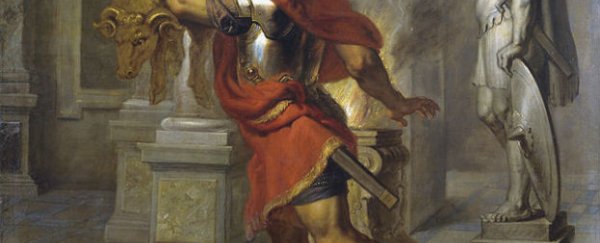Geologists in Georgia have found evidence that links one of the most famous Greek myths to actual events that took place in an ancient city steeped in gold.
Jason, mythological Greek hero dreamed up some time around 300 BC, will forever be tied in mythology to the fantastical golden fleece. Legend has it, in the era prior to the Trojan War, Jason banded together with a small group of similarly heroic figures known collectively as the Argonauts to battle a series of trials - including lunch-stealing harpies and loin-cloth-wearing giants - to find the pelt of the famed golden-haired, winged ram of Zeus, the god of sky and thunder.
Jason believed that possession of the fleece, said to be held by the ancient kingdom of Colchis in the Svaneti region of modern Georgia, would help to reinstate his usurped father, Aeson, as king of Thessaly in Greece.
It's one of the best-known tales in Greek mythology, but archaeologists and geologists alike have struggled to make sense of what the golden fleece could symbolise, or have been inspired by. While some scholars insist that the Greek myths are simple works of fantasy told with some kind of moral or lesson in mind, says Liz Leafloor at Ancient Origins, the fact that the Greek word mythos means "word" or "true narrative" and the closely related word myo means "to teach" has led others to suggest they are rooted in some kind of reality.
Now, a team led by geologist Avtandil Okrostsvaridze from Ilia State University in Georgia has found evidence to suggest that the myth of Jason and the Golden Fleece was indeed based on historical events related to ancient gold extraction techniques.
Between 2002 and 2010, the team carried out field work in Svaneti region on the east coast of the Black Sea, where they compared the available geological data, artefacts, myths and historical sources surrounding the kingdom of Colchis. Publishing in the current edition of Quaternary International, they now suggest that the myth "took inspiration from an actual voyage sometime between 3,300 and 3,500 years ago".
Jason and the Argonauts' destination was the kingdom of Colchis, a large, coastal city famous at the time for harbouring a great wealth of gold. "According to Greek mythology and historical sources the ancient Georgian Kingdom of Colchis was rich in 'gold sands' and the natives mined this metal from the rivers, using special wooden vessels and sheepskins," the researchers write. As a result of their geological investigation, they confirmed that still today in the Svaneti region, the rivers that snake down the sides of the mountains contain tiny particles of gold that have worn off the edges of the rocks.
 Gold grains washed from alluvial placers of the River Quani. Credit: A. Okrostsvaridze et. al.
Gold grains washed from alluvial placers of the River Quani. Credit: A. Okrostsvaridze et. al.
The researchers also found that the Svaneti region contains numerous goldfields and river placers - an accumulation of valuable minerals - one of which they estimate contains around 65 to 70 tonnes of gold. They suggest that this particular resource was one of the main suppliers of alluvial, or river, gold in Svaneti, which the locals have been using sheepskin to extract for thousands of years. This ancient tradition was likely passed down from time that the mythology of Jason was being formed, the researchers suggest.
So it turns out that the theory proposed way back in the 2nd century AD by Roman historian, Apian Alexandrine - that the myth was based on a real journey to Colchis to obtain the famed sheepskin gold mining technique - was likely to have been accurate.
"We think, from our investigations, that the bedrock and placer gold contents of this region give grounds to believe that there was enough gold in this region to describe Svaneti as 'the country rich of this noble metal'." they conclude. "The end result of this technique of gold recovery river gravels was a gold imprinted sheepskin, giving rise to the romantic and unidentified phenomena of the 'Golden Fleece' in the civilised world."
For more information about Okrostsvaridze's research, here's a freely available study published in the journal Geology in 2010, and you can watch a video by University of Cambridge researchers on the ancient wealth of Colchis below:

Sources: Quaternary International, Ancient Origins
